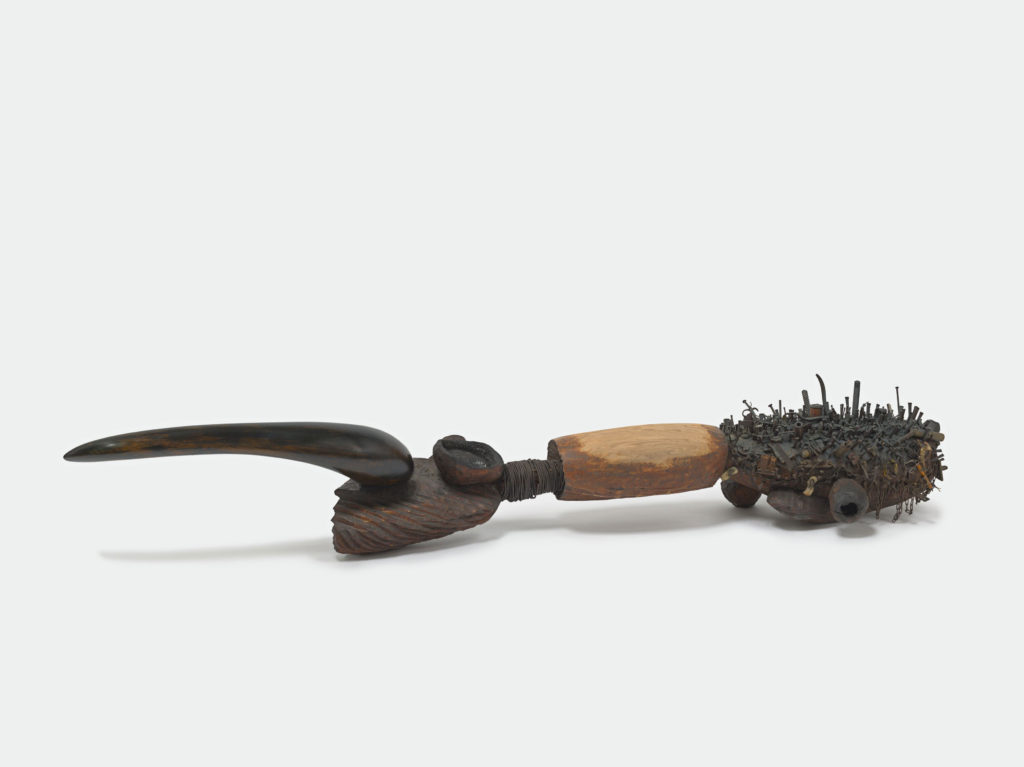The long and illustrious career of Jack Whitten (NA 2016) is marked by constant experimentation. For over 50 years, he masterfully explored the possibilities of abstract painting, regularly utilizing untraditional materials and responding to changing technologies, which garnered critical attention. Odyssey: Jack Whitten Sculpture, 1963 – 2017, on view at the Met Breuer through December 2, 2018, presents the first major showing of Whitten’s under-recognized sculptural practice, in dialogue with his monumental paintings. Co-organized by the Baltimore Museum of Art and the Metropolitan Museum of Art, Odyssey features forty sculptures made over five decades, juxtaposed with eighteen large-scale abstract paintings, including the entirety of Whitten’s Black Monolith series (1988 – 2017) and a selection of African, Cycladic, Minoan, Mycenaean, and American works from the Met’s permanent collection. Throughout his remarkable career, Whitten held an ongoing interest in new technologies and was committed to challenging binaries within art; just as he considered abstract painting to be parallel to photo-electronic or photo-chemical processes, he found painting and sculpture to be tangential parts of his own practice, often incorporating sculptural techniques onto flat works and using carving or assemblage to inform his paintings.

Whitten’s complex sculptures are intimate and biographical; they reflect his trajectory as an artist while paying homage to what he held dear: his wife, Mary; his daughter, Mirsini; their summer retreats to Agia Galini, Crete, which offered both artistic inspiration and refuge from the commercial bustle of the New York art scene; as well as his ongoing love and curiosity for art history. The elaborate sculptures, composed of carved wood and detritus such as bone, marble, metal, fishing line, and circuit boards, are at once totems, icons, and memorials. The diversity of material is further emphasized by the diversity of inspiration; African sculpture, Southern American ceramics, and ancient Mediterranean artifacts influenced Whitten’s aesthetic and material choices. For example, the earliest sculptures in the exhibition, made in 1962 while he was a student at the Cooper Union in New York, are a series of carved wood face jugs, lacquered with shoe polish, which recall the ceramic works by enslaved potters in South Carolina during the mid-19th century.

Whitten’s early years in New York were rich with art and activism, having met figures such as Norman Lewis, Willem de Kooning (ANA 1980, NA 1994), Amiri Baraka, and Ornette Coleman. He developed a unique and technically rigorous style of abstract painting while simultaneously deepening his knowledge of African art by visiting the collections of the Met and the Brooklyn Museum, as well as the private collection of gallerist Allan Stone. Like many of his peers who were involved with the civil rights movement, Whitten reclaimed African art forms and techniques into his own practice. Homage to Malcolm (1965), is composed of American elm, wire, and nails, and recalls minkisi—Kongo power figures that are spiritual and protective vessels. The sculpture resembles a totem on its side and pays homage to the civil rights leader’s struggle, labor, and memory in connection to his ancestral homeland, further emphasized by the minkisi that is on view nearby. With this work, and others of this time period, Whitten developed characteristics that would remain constant in his sculptures, including embedding mixed media into wood, and a delicate play between organic shapes and asymmetrical compositions.

Among the sculptures are Whitten’s eleven Black Monolith paintings, each paying homage to an African American visionary, including Ralph Ellison, Maya Angelou, Terry Adkins, and Amiri Baraka. The dazzling, mosaic-like paintings are composed of tesserae which Whitten molded himself with acrylic, plastic packaging, or bottle caps. The resulting designs, each tailored to the subject of homage, are intricate and animated. The dynamic patterns capture and reflect light, almost evoking a spiritual quality of being lit from within. Whitten’s approach to these paintings demonstrate the same consideration of material, space, and composition as his sculptures, suggesting that he considered these seemingly disparate practices were united in more ways than one. Whitten’s later work shows his engagement and desire to embrace new technology. A 2013 sculpture, Technological Totem Pole, is composed of mulberry wood, carved to resemble totem poles created by Native Americans in the Northwest United States, and embedded with electronic components such as an alarm clock, circuit boards, and a flip cellphone. At play are ideas about nature versus the artificial and the impact of technology and waste. With this work, and the rest of the exhibition, Whitten’s innovation in painting and three-dimensional work is cemented; his politically charged methods and aesthetics continue to break dichotomies and expand the standards and narratives of modernist art.
Odyssey: Jack Whitten Sculpture, 1963 – 2017, is presented at the Met Breuer in New York, NY, from September 6 – December 2, 2018.
Doris Zhao is the Curatorial Assistant at The Studio Museum in Harlem. Her recent exhibitions include Harlem Postcards: Wish You Were Here, Regarding the Figure and Surface Area: Selections from the Permanent Collection. She assisted in organizing numerous exhibitions and publications, most recently, Fictions. In addition to exhibitions, she runs the Harlem Postcards project and has contributed essays to various publications, including Prospect.4: The Lotus in Spite of the Swamp and forthcoming Studio Museum publications. She holds her MA in Modern and Contemporary Art, Critical and Curatorial Studies from Columbia University.

